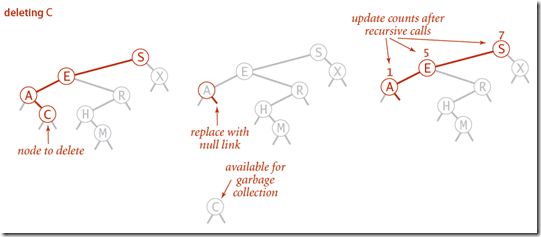二叉查找树的查找、插入和删除 - Java实现
http://www.cnblogs.com/yangecnu/p/Introduce-Binary-Search-Tree.html
作者: yangecnu(yangecnu's Blog on 博客园)
出处:http://www.cnblogs.com/yangecnu/
英文原文的出处:
http://algs4.cs.princeton.edu/32bst/
前文介绍了符号表的两种实现,无序链表和有序数组,无序链表在插入的时候具有较高的灵活性,而有序数组在查找时具有较高的效率,本文介绍的二叉查找树(Binary Search Tree,BST)这一数据结构综合了以上两种数据结构的优点。
二叉查找树具有很高的灵活性,对其优化可以生成平衡二叉树,红黑树等高效的查找和插入数据结构,后文会一一介绍。
一 定义
二叉查找树(Binary Search Tree),也称有序二叉树(ordered binary tree),排序二叉树(sorted binary tree),是指一棵空树或者具有下列性质的二叉树:
1. 若任意节点的左子树不空,则左子树上所有结点的值均小于它的根结点的值;
2. 若任意节点的右子树不空,则右子树上所有结点的值均大于它的根结点的值;
3. 任意节点的左、右子树也分别为二叉查找树。
4. 没有键值相等的节点(no duplicate nodes)。
如下图,这个是普通的二叉树:
在此基础上,加上节点之间的大小关系,就是二叉查找树:
二 实现
在实现中,我们需要定义一个内部类Node,它包含两个分别指向左右节点的Node,一个用于排序的Key,以及该节点包含的值Value,还有一个记录该节点及所有子节点个数的值Number。
public class BinarySearchTreeSymbolTable<TKey, TValue> : SymbolTables<TKey, TValue> where TKey : IComparable<TKey>, IEquatable<TValue>
{
private Node root;
private class Node
{
public Node Left { get; set; }
public Node Right { get; set; }
public int Number { get; set; }
public TKey Key { get; set; }
public TValue Value { get; set; }
public Node(TKey key, TValue value, int number)
{
this.Key = key;
this.Value = value;
this.Number = number;
}
}
...
}
查找
查找操作和二分查找类似,将key和节点的key比较,如果小于,那么就在Left Node节点查找,如果大于,则在Right Node节点查找,如果相等,直接返回Value。
该方法实现有迭代和递归两种。
递归的方式实现如下:
public override TValue Get(TKey key)
{
TValue result = default(TValue);
Node node = root;
while (node != null)
{
if (key.CompareTo(node.Key) > 0)
{
node = node.Right;
}
else if (key.CompareTo(node.Key) < 0)
{
node = node.Left;
}
else
{
result = node.Value;
break;
}
}
return result;
}
迭代的如下:
public TValue Get(TKey key)
{
return GetValue(root, key);
}
private TValue GetValue(Node root, TKey key)
{
if (root == null) return default(TValue);
int cmp = key.CompareTo(root.Key);
if (cmp > 0) return GetValue(root.Right, key);
else if (cmp < 0) return GetValue(root.Left, key);
else return root.Value;
}
插入
插入和查找类似,首先查找有没有和key相同的,如果有,更新;如果没有找到,那么创建新的节点。并更新每个节点的Number值,代码实现如下:
public override void Put(TKey key, TValue value)
{
root = Put(root, key, value);
}
private Node Put(Node x, TKey key, TValue value)
{
//如果节点为空,则创建新的节点,并返回
//否则比较根据大小判断是左节点还是右节点,然后继续查找左子树还是右子树
//同时更新节点的Number的值
if (x == null) return new Node(key, value, 1);
int cmp = key.CompareTo(x.Key);
if (cmp < 0) x.Left = Put(x.Left, key, value);
else if (cmp > 0) x.Right = Put(x.Right, key, value);
else x.Value = value;
x.Number = Size(x.Left) + Size(x.Right) + 1;
return x;
}
private int Size(Node node)
{
if (node == null) return 0;
else return node.Number;
}
插入操作图示如下:
下面是插入动画效果:
随机插入形成树的动画如下,可以看到,插入的时候树还是能够保持近似平衡状态:
最大最小值
如下图可以看出,二叉查找树的最大最小值是有规律的:
从图中可以看出,二叉查找树中,最左和最右节点即为最小值和最大值,所以我们只需迭代调用即可。
public override TKey GetMax()
{
TKey maxItem = default(TKey);
Node s = root;
while (s.Right != null)
{
s = s.Right;
}
maxItem = s.Key;
return maxItem;
}
public override TKey GetMin()
{
TKey minItem = default(TKey);
Node s = root;
while (s.Left != null)
{
s = s.Left;
}
minItem = s.Key;
return minItem;
}
以下是递归的版本:
public TKey GetMaxRecursive()
{
return GetMaxRecursive(root);
}
private TKey GetMaxRecursive(Node root)
{
if (root.Right == null) return root.Key;
return GetMaxRecursive(root.Right);
}
public TKey GetMinRecursive()
{
return GetMinRecursive(root);
}
private TKey GetMinRecursive(Node root)
{
if (root.Left == null) return root.Key;
return GetMinRecursive(root.Left);
}
Floor和Ceiling
查找Floor(key)的值就是所有<=key的最大值,相反查找Ceiling的值就是所有>=key的最小值,下图是Floor函数的查找示意图:
以查找Floor为例,我们首先将key和root元素比较,如果key比root的key小,则floor值一定在左子树上;如果比root的key大,则有可能在右子树上,当且仅当其右子树有一个节点的key值要小于等于该key;如果和root的key相等,则floor值就是key。根据以上分析,Floor方法的代码如下,Ceiling方法的代码类似,只需要把符号换一下即可:
public TKey Floor(TKey key)
{
Node x = Floor(root, key);
if (x != null) return x.Key;
else return default(TKey);
}
private Node Floor(Node x, TKey key)
{
if (x == null) return null;
int cmp = key.CompareTo(x.Key);
if (cmp == 0) return x;
if (cmp < 0) return Floor(x.Left, key);
else
{
Node right = Floor(x.Right, key);
if (right == null) return x;
else return right;
}
}
删除
删除元素操作在二叉树的操作中应该是比较复杂的。首先来看下比较简单的删除最大最小值得方法。
以删除最小值为例,我们首先找到最小值,及最左边左子树为空的节点,然后返回其右子树作为新的左子树。操作示意图如下:
代码实现如下:
public void DelMin()
{
root = DelMin(root);
}
private Node DelMin(Node root)
{
if (root.Left == null) return root.Right;
root.Left = DelMin(root.Left);
root.Number = Size(root.Left) + Size(root.Right) + 1;
return root;
}
删除最大值也是类似。
现在来分析一般情况,假定我们要删除指定key的某一个节点。这个问题的难点在于:删除最大最小值的操作,删除的节点只有1个子节点或者没有子节点,这样比较简单。但是如果删除任意节点,就有可能出现删除的节点有0个,1 个,2个子节点的情况,现在来逐一分析。
当删除的节点没有子节点时,直接将该父节点指向该节点的link设置为null。
当删除的节点只有1个子节点时,将该自己点替换为要删除的节点即可。
当删除的节点有2个子节点时,问题就变复杂了。
假设我们删除的节点t具有两个子节点。因为t具有右子节点,所以我们需要找到其右子节点中的最小节点,替换t节点的位置。这里有四个步骤:
1. 保存带删除的节点到临时变量t
2. 将t的右节点的最小节点min(t.right)保存到临时节点x
3. 将x的右节点设置为deleteMin(t.right),该右节点是删除后,所有比x.key最大的节点。
4. 将x的做节点设置为t的左节点。
整个过程如下图:
对应代码如下:
public void Delete(TKey key)
{
root =Delete(root, key);
}
private Node Delete(Node x, TKey key)
{
int cmp = key.CompareTo(x.Key);
if (cmp > 0) x.Right = Delete(x.Right, key);
else if (cmp < 0) x.Left = Delete(x.Left, key);
else
{
if (x.Left == null) return x.Right;
else if (x.Right == null) return x.Left;
else
{
Node t = x;
x = GetMinNode(t.Right);
x.Right = DelMin(t.Right);
x.Left = t.Left;
}
}
x.Number = Size(x.Left) + Size(x.Right) + 1;
return x;
}
private Node GetMinNode(Node x)
{
if (x.Left == null) return x;
else return GetMinNode(x.Left);
}
以上二叉查找树的删除节点的算法不是完美的,因为随着删除的进行,二叉树会变得不太平衡,下面是动画演示。
三 分析
二叉查找树的运行时间和树的形状有关,树的形状又和插入元素的顺序有关。在最好的情况下,节点完全平衡,从根节点到最底层叶子节点只有lgN个节点。在最差的情况下,根节点到最底层叶子节点会有N各节点。在一般情况下,树的形状和最好的情况接近。
在分析二叉查找树的时候,我们通常会假设插入的元素顺序是随机的。对BST的分析类似与快速排序中的查找:
BST中位于顶部的元素就是快速排序中的第一个划分的元素,该元素左边的元素全部小于该元素,右边的元素均大于该元素。
对于N个不同元素,随机插入的二叉查找树来说,其平均查找/插入的时间复杂度大约为2lnN,这个和快速排序的分析一样,具体的证明方法不再赘述,参照快速排序。
四 总结
有了前篇文章 二分查找的分析,对二叉查找树的理解应该比较容易。下面是二叉查找树的时间复杂度:
它和二分查找一样,插入和查找的时间复杂度均为lgN,但是在最坏的情况下仍然会有N的时间复杂度。原因在于插入和删除元素的时候,树没有保持平衡。我们追求的是在最坏的情况下仍然有较好的时间复杂度,这就是后面要讲的平衡查找树的内容了。下文首先讲解平衡查找树的最简单的一种:2-3查找树。
希望本文对您了解二叉查找树有所帮助。
附上我的代码
public class BST { public TreeNode search(TreeNode root, int val) { if(root == null) { return root; } if(root.val == val) { return root; } else if(root.val > val) { return search(root.left, val); } else { return search(root.right, val); } } public TreeNode insert(TreeNode root, int val) { if(root == null) { TreeNode node = new TreeNode(val); return node; } if(root.val > val) { root.left = insert(root.left, val); } else if(root.val < val) { root.right = insert(root.right, val); } return root; } public TreeNode delete(TreeNode root, int val) { if(root.val > val) { root.left = delete(root.left, val); } else if(root.val < val) { root.right = delete(root.right, val); } else { if(root == null) { return null; } if(root.left == null && root.right == null) { return null; } if(root.left == null) { return root.right; } if(root.right == null) { return root.left; } TreeNode temp = root; root = getSuccessor(root); root.right = deleteMin(root.right); root.left = temp.left; } return root; } public TreeNode deleteMin(TreeNode root) { if(root.left != null) { root.left = deleteMin(root.left); } else { return root.right; } return root; } public TreeNode getSuccessor(TreeNode root) { root = root.right; while(root.left != null) { root = root.left; } return root; } }













